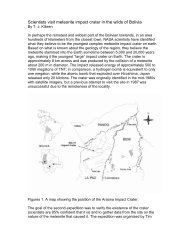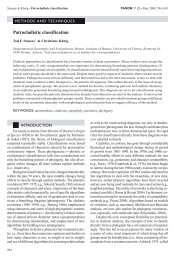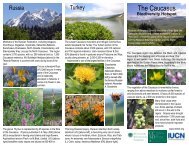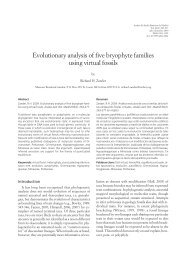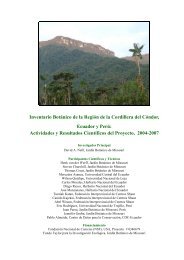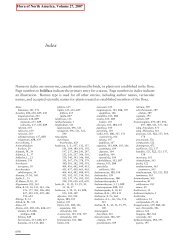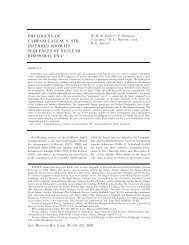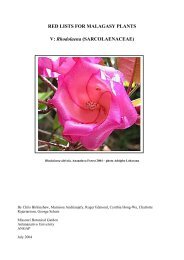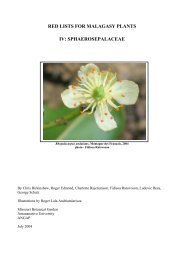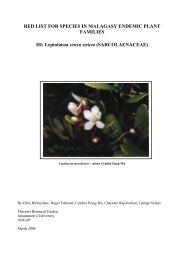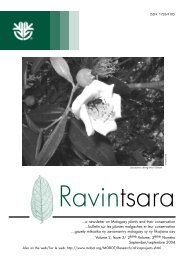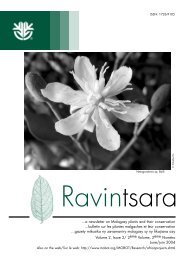re-evaluation of tortella - Missouri Botanical Garden
re-evaluation of tortella - Missouri Botanical Garden
re-evaluation of tortella - Missouri Botanical Garden
Create successful ePaper yourself
Turn your PDF publications into a flip-book with our unique Google optimized e-Paper software.
macroscopically in its spiral, twisting leaf apices and<br />
glistening leaf bases due to inflated or lax, clear cells,<br />
but it never has the long, needle-like mucro and the<br />
margins a<strong>re</strong> strongly <strong>re</strong>curved, with the costa dull on the<br />
back. The<strong>re</strong> a<strong>re</strong> usually one or mo<strong>re</strong> coarse, ir<strong>re</strong>gular<br />
teeth associated with the short mucro or leaf apex.<br />
Trichostomum tenuirost<strong>re</strong>, with leaves also<br />
spirally twisted when dry, has hyaline proximal cells<br />
that extend indistinctly only a short way up the margin<br />
by a few cells in width, and the stem is not radiculose.<br />
In fruiting specimens, Tortella tortuosa will have long,<br />
spiraled peristome teeth. The teeth <strong>of</strong> Trichostomum a<strong>re</strong><br />
e<strong>re</strong>ct or slightly inclined and <strong>of</strong>ten rudimentary.<br />
Trichostomum tenuirost<strong>re</strong> usually has a large and<br />
distinct stem central strand, and the apex <strong>of</strong> the leaf<br />
<strong>of</strong>ten has low and distant teeth.<br />
The traditional t<strong>re</strong>atment <strong>of</strong> Tortella tortuosa<br />
in North America is <strong>re</strong>markable for its lack <strong>of</strong> problems<br />
in taxonomy. It leaves one unp<strong>re</strong>pa<strong>re</strong>d for the<br />
p<strong>re</strong>sentation <strong>of</strong> the species in the European literatu<strong>re</strong>. In<br />
Europe, a continent <strong>of</strong> physiographically complex<br />
micro<strong>re</strong>gions, the variation is either divided into several<br />
species or is conside<strong>re</strong>d to be a single species <strong>of</strong> g<strong>re</strong>at<br />
morphological variability united by a welter <strong>of</strong><br />
intergrading forms. Podpera's list (1954) <strong>of</strong> subspecific<br />
taxa shows five forms for the var. tortuosa and 22<br />
additional infraspecific taxa for a total <strong>of</strong> 27,<br />
demonstrating that the species is "oecomorphis dives"<br />
indeed.<br />
But how is it that North American Tortella<br />
tortuosa has been <strong>re</strong>ported as so uniform in its<br />
characteristics throughout the continent, and can this<br />
fact contribute to <strong>re</strong>solving some European problems by<br />
assuring systematists that some <strong>of</strong> the European<br />
infraspecific taxa a<strong>re</strong>, in fact, species? For example,<br />
the<strong>re</strong> is the issue <strong>of</strong> the central strand and its utility in<br />
giving specific rank to such taxa as Tortella<br />
bambergeri, T. brotheri (Broth.) Broth., and T.<br />
fleischeri (Bauer) Amann, all conside<strong>re</strong>d by various<br />
authors as varieties, forms, subspecies or synonyms <strong>of</strong><br />
T. tortuosa, yet all th<strong>re</strong>e have a distinct stem central<br />
strand.<br />
Meylan (1921) wrote that Tortella fleischeri<br />
and T. bambergeri in the F<strong>re</strong>nch Jura Mountains "a<strong>re</strong><br />
probably only forms or races <strong>of</strong> the polymorphic T.<br />
tortuosa. While studying the constancy <strong>of</strong> their principal<br />
diffe<strong>re</strong>ntiating character, which is the p<strong>re</strong>sence <strong>of</strong> the<br />
central strand, I can say in my opinion, this character<br />
has little value for this group. Typical T. tortuosa also<br />
sometimes p<strong>re</strong>sents a stem in which the central strand is<br />
completely absent, sometimes, on the contrary, a central<br />
strand with various deg<strong>re</strong>es <strong>of</strong> development. I have<br />
seen, for example, specimens well fruiting and<br />
<strong>re</strong>p<strong>re</strong>senting the typical species to include a large,<br />
distinct central strand. Limpricht and other authors,<br />
mainly Germans, have accorded a very g<strong>re</strong>at importance<br />
to the p<strong>re</strong>sence or absence <strong>of</strong> a central strand, mainly in<br />
various groups."<br />
In my experience with North American species<br />
<strong>of</strong> Tortella, the central strands, when they occur, have<br />
18<br />
little "various deg<strong>re</strong>es <strong>of</strong> development." Cells <strong>of</strong> the<br />
central cylinder in species characterized as having no<br />
central strand may get thinner-walled in the center <strong>of</strong><br />
the stem, but the definition <strong>of</strong> a central strand used he<strong>re</strong><br />
is a group <strong>of</strong> cells (mo<strong>re</strong> than two) in the stem center<br />
that a<strong>re</strong> abruptly smaller than the surrounding cells and<br />
have thinner walls.<br />
Throughout the range <strong>of</strong> Tortella tortuosa and<br />
its varieties arctica and fragilifolia, the occur<strong>re</strong>nce <strong>of</strong> a<br />
definite stem central strand was only found in a<br />
specimen from South Dakota in an otherwise typical<br />
plant, and another in Montana, one from Michigan<br />
(Emmet Co. on shady soil, Cecil Bay, 4 miles W <strong>of</strong><br />
Mackinaw City, R.R. I<strong>re</strong>land 4379, UBC); also in var.<br />
fragilifolia: Vermont, Haring 1939, NY, CANM (see<br />
discussion below).<br />
Sections we<strong>re</strong> also made at the bases <strong>of</strong> the<br />
longest stems examined (to 6 cm) to see whether a<br />
central strand may be exp<strong>re</strong>ssed in the initial stages <strong>of</strong><br />
growth, and lost later, or lost in branches, but all such<br />
specimens proved to lack a central strand anywhe<strong>re</strong><br />
throughout the stem length.<br />
The t<strong>re</strong>atment <strong>of</strong> Tortella tortuosa in Mexico<br />
(Zander 1994d), whe<strong>re</strong> a central strand is <strong>re</strong>ported for<br />
the species, is somewhat problematical due to the<br />
confusion <strong>of</strong> several specimens <strong>of</strong> Pseudosymblepharis<br />
schimperiana, which does have a central strand, with<br />
specimens used in p<strong>re</strong>paration for that description <strong>of</strong> T.<br />
tortuosa. In fact, the illustration for the latter species is<br />
probably that <strong>of</strong> Pseudosymblepharis, and not T.<br />
tortuosa.<br />
Ascribing too much "polymorphism" to a<br />
single species, Tortella tortuosa s.l., in Europe may<br />
disguise the floristic conclusion that Europe is an<br />
important center <strong>of</strong> diversity in the genus Tortella in the<br />
North Temperate Zone.<br />
4b. TORTELLA TORTUOSA VAR. ARCTICA Plate 5<br />
Tortella tortuosa var. arctica (Arn.) Broth. in Fedch.,<br />
Fl. As. Ros. 13: 160. 1918.<br />
Mollia tortuosa var. arctica Arn., Ark. f. Bot.<br />
13(2): 51. 1913.<br />
Tortella arctica (Arn.) Crundw. & Nyh., Trans.<br />
Brit. Bryol. Soc. 4: 187. 1963.<br />
Plants <strong>re</strong>d-g<strong>re</strong>en or yellow-g<strong>re</strong>en with a coppery sheen<br />
above to black below, in coarse, dense, stiff tufts or<br />
deep sods, elongate. Stems 0.8–7 cm high, leaves<br />
densely disposed on stem or in dense annual whorls<br />
distinctly separated by less foliose <strong>re</strong>gions, terminating<br />
in a thick multi-branched comal tuft, leaf bases hidden<br />
in foliose <strong>re</strong>gions, exposed in elongated ones, branch<br />
innovations disposed throughout the stem, central strand<br />
absent or occasionally p<strong>re</strong>sent, sclerodermis robust, 4–<br />
5(–6) cells thick, cells <strong>of</strong> central cylinder <strong>re</strong>latively<br />
thick-walled, tomentum absent or occasional, especially<br />
at the bases <strong>of</strong> innovations, or inconspicuous and hidden<br />
in the leaf axils. Stem leaves coarse, uniform in size<br />
along the stem, somewhat larger at the stem apex, 2.3–6





